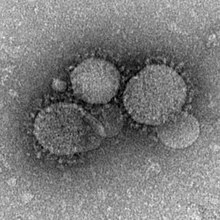中東呼吸症候群冠狀病毒
| 中東呼吸綜合症冠狀病毒 | |
|---|---|

| |
| 中東冠狀病毒負染電子顯微映像。病毒表面有刺狀突起物,此乃這一類病毒的典型特徵。 | |
| 病毒分類 | |
| (未分級): | 病毒 Virus |
| 域: | 核糖病毒域 Riboviria |
| 界: | 正核糖病毒界 Orthornavirae |
| 門: | 小核糖病毒門 Pisuviricota |
| 綱: | 小南嵌套病毒綱 Pisoniviricetes |
| 目: | 套式病毒目 Nidovirales |
| 科: | 冠狀病毒科 Coronaviridae |
| 屬: | 乙型冠狀病毒屬 Betacoronavirus |
| 種: | 中東呼吸綜合症冠狀病毒 Middle East respiratory
syndrome-related coronavirus |
中東呼吸系統綜合症冠狀病毒是導致中東呼吸系統綜合症的病原體(英文縮寫:MERS-CoV 或代號:EMC/2012『HCoV-EMC/2012』)引起[1],有別於嚴重急性呼吸系統綜合症冠狀病毒和普通傷風冠狀病毒。[2]中東冠狀病毒具單鏈核糖核酸,為β冠狀病毒屬的新成員,按基因組區別被分為了甲、乙兩大系統發生分支;最早期的感染病例是由甲類病毒造成,與後來的不同。[3]
中東冠狀病毒主要襲擊支氣管上的無纖毛上皮細胞。它能避開宿主體內的起始免疫反應,並阻止免疫細胞分泌干擾素。此向性在眾多呼吸系統病毒裡實屬獨特,因為其他病毒大多都襲擊纖毛上皮細胞。[4][5]
傳播途徑
[編輯]2010年至2013年間進行的一項研究,在310頭單峰駱駝的身上評估MERS的發病率,揭示出MERS冠狀病毒中和抗體在這些動物的血清中的滴度高[6]。進一步對沙特單峰駱駝鼻拭子上的MERS冠狀病毒進行的研究測序,發現它們的序列與以前的人類測序隔離。從個別駱駝的身上還發現鼻咽處有一個以上的基因組變體[7]。據報一名沙特男子給幾頭生病駱駝的鼻子敷藥後七天發病,後來他和一隻駱駝都被發現帶有相同的MERS冠狀病毒毒株。現在尚未明確病毒從駱駝傳播給人類的方法[8][9]。世界衛生組織建議避免接觸駱駝,只吃全熟的駱駝肉,用巴氏法殺毒的駱駝奶,避免飲用駱駝尿。駱駝尿被認為是各種中東疾病的治療藥物[10]。沙特農業部建議人們避免接觸駱駝,或是在接觸時佩戴呼吸面罩[11]。有些人不聽政府的意見,親吻了駱駝以表蔑視[12]。
有限的證據表明MERS冠狀病毒不會在人與人間持續傳播,無論是在家裡或是在醫院等衛生保健機構[13][14]。大多數的傳播發生在「密切接觸醫療機構或居家危重病人的情況下」,並沒有症狀表明會傳播給無症狀感染者[15]。群集範圍從1人到26人,平均數為2.7[16]。
參考文獻
[編輯]- ^ De Groot RJ; et al. Middle East Respiratory Syndrome Coronavirus (MERS-CoV): Announcement of the Coronavirus Study Group. Journal of Virology. 2013-05-15, 87 (14): 7790–2. PMC 3700179
 . PMID 23678167. doi:10.1128/JVI.01244-13.
. PMID 23678167. doi:10.1128/JVI.01244-13.
- ^ ECDC Rapid Risk Assessment - Severe respiratory disease associated with a novel coronavirus (PDF). 2013-02-19 [08-06-2015]. (原始內容 (PDF)存檔於2013-05-31).
- ^ MERS Coronaviruses in Dromedary Camels, Egypt. 06-2014 [08-06-2015]. (原始內容存檔於2014-03-08).
- ^ Kindler, E.; Jónsdóttir, H. R.; Muth, D.; Hamming, O. J.; Hartmann, R.; Rodriguez, R.; Geffers, R.; Fouchier, R. A.; Drosten, C. Efficient Replication of the Novel Human Betacoronavirus EMC on Primary Human Epithelium Highlights Its Zoonotic Potential. MBio. 2013, 4 (1): e00611–12. PMC 3573664
 . PMID 23422412. doi:10.1128/mBio.00611-12.
. PMID 23422412. doi:10.1128/mBio.00611-12.
- ^ Raj, V. S.; Mou, H.; Smits, S. L.; Dekkers, D. H.; Müller, M. A.; Dijkman, R.; Muth, D.; Demmers, J. A.; Zaki, A. Dipeptidyl peptidase 4 is a functional receptor for the emerging human coronavirus-EMC. Nature. 03-2013, 495 (7440): 251–4. PMID 23486063. doi:10.1038/nature12005.
- ^ Hemida, MG; et al. Middle East Respiratory Syndrome (MERS) coronavirus seroprevalence in domestic livestock in Saudi Arabia. Eurosurveillance. 2013-12-12, 18 (50) [2015-06-09]. (原始內容存檔於2015-04-24).

- ^ Briese, T.; et al. Middle East Respiratory Syndrome Coronavirus Quasispecies That Include Homologues of Human Isolates Revealed through Whole-Genome Analysis and Virus Cultured from Dromedary Camels in Saudi Arabia. mBio. 2014-04-29 [2014-05-20]. doi:10.1128/mBio.01146-14. (原始內容存檔於2014-05-02).

- ^ Gallagher, James. Camel infection 'led to Mers death'. BBC News. 2014-06-05 [2014-06-05]. (原始內容存檔於2014-06-05).
- ^ Azhar, E. I.; et al. Evidence for Camel-to-Human Transmission of MERS Coronavirus. The New England Journal of Medicine. 2014-06-04 [2014-06-06]. doi:10.1056/NEJMoa1401505. (原始內容存檔於2014-06-06).
- ^ WHO warns about camel products, contact over rising MERS concerns | CTV News. CTV News. 2014-05-10 [2014-05-22]. (原始內容存檔於2014-05-22).
- ^ Mers virus: Saudis warned to wear masks near camels. BBC News. 2014-05-11 [2014-05-22]. (原始內容存檔於2014-05-19).
- ^ Saudi Arabia: Farmers flout Mers warning by kissing camels. BBC News. 2014-05-13 [2014-05-22]. (原始內容存檔於2014-05-21).
- ^ The Health Protection Agency (HPA) UK Novel Coronavirus Investigation team. State of Knowledge and Data Gaps of Middle East Respiratory Syndrome Coronavirus (MERS-CoV) in Humans. Eurosurveillance. 2013-03-14 [2014-05-21]. doi:10.1371/currents.outbreaks.0bf719e352e7478f8ad85fa30127ddb8. (原始內容存檔於2014-05-21).

- ^ Assiri, A.; et al. Hospital Outbreak of Middle East Respiratory Syndrome Coronavirus. The New England Journal of Medicine. 2013-01-08 [2014-05-20]. doi:10.1056/NEJMoa1306742. (原始內容存檔於2014-06-10).
- ^ Rapid advice note on home care for patients with Mi ddle East respiratory syndrome coronavirus (MERS-CoV) infecti on presenting with mild symptoms and management of contacts (PDF). WHO. 2013-08-08 [2014-05-21]. (原始內容存檔 (PDF)於2014-05-14).
- ^ Cauchemez, S.; et al. Middle East respiratory syndrome coronavirus: quantification of the extent of the epidemic, surveillance biases, and transmissibility. The Lancet Infectious Diseases. January 2014 [2014-05-21]. doi:10.1016/S1473-3099(13)70304-9. (原始內容存檔於2015-09-24).
外部連結
[編輯]- Emergence of the Middle East Respiratory Syndrome Coronavirus(頁面存檔備份,存於網際網路檔案館)
- MERS-CoV Complete Genome(頁面存檔備份,存於網際網路檔案館)
- Emerging viruses
- Molecular Illustration of MERS-Coronavirus(頁面存檔備份,存於網際網路檔案館)
- Philippines still MERS-CoV free – DOH(頁面存檔備份,存於網際網路檔案館)

